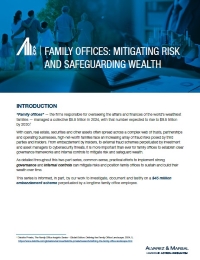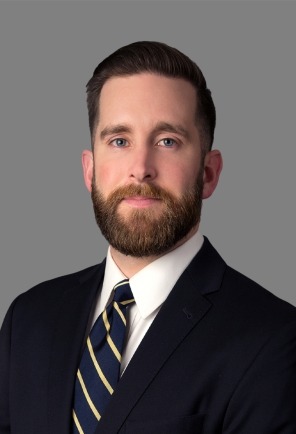Family Offices: Mitigating Risk and Safeguarding Wealth Part II
INTRODUCTION
“Family offices” — the firms responsible for overseeing the affairs and finances of the world’s wealthiest families — managed a collective $5.5 trillion in 2024, with that number expected to rise to $9.5 trillion by 2030.[1]
With cash, real estate, securities and other assets often spread across a complex web of trusts, partnerships and operating businesses, high-net-worth families face an increasing array of fraud risks posed by third parties and insiders. From embezzlement by insiders, to external fraud schemes perpetuated by investment and asset managers to cybersecurity threats, it is more important than ever for family offices to establish clear governance frameworks and internal controls to mitigate risk and safeguard wealth.
As detailed throughout this two-part series, common-sense, practical efforts to implement strong governance and fraud risk management can mitigate risks and position family offices to sustain and build their wealth over time.
This series is informed, in part, by our work to investigate, document and testify on a $45 million embezzlement scheme perpetuated by a longtime family office employee.
Read Part I of our series.[2]

| Download the Series >>> |
PART II: Fraud Risk Management
Family offices juggle numerous responsibilities while managing substantial wealth. In some cases, as long as key activities such as investments and disbursements appear to continue without interruption, it can be tempting for family members to overlook or procrastinate on digging into what seem like minor gaps in governance, processes or controls.
Beyond the expectation to manage investments, a recent Citi survey found that more than half of family offices expect their head of family office to also play the role of risk manager.[3] Tasked with developing and implementing investment strategy, coordinating various tasks and activities and overseeing a sustainable, multi-generational succession plan, fraud risk management can fall to lower priority on the family office head’s ever-growing list of to-dos. But beyond the family office head — and even beyond other formal committees defined by governance documents — all family members should understand how to recognize and react to common fraud-related red flags.
Asset-misappropriation schemes, frequently perpetuated by insiders and employees in trusted positions, comprise nearly 90 percent of all reported fraud cases and often go undetected for a year, costing organizations an average of $100,000.[4] Larger embezzlement and asset misappropriation cases, as reported publicly in media and by prosecutors, can last decades and erode tens of millions before detection.
Below, we define several best practices that family offices of any size — whether professionally managed or not — should consider to prevent and detect common fraud risks. We also describe the associated red flags and warning signs that your organization should recognize.
- Maintain familiarity and visibility into core family accounts, including assets and investments — particularly when key finance and accounting operations are outsourced to third parties. Even though most family offices outsource core functions to external providers, a Dentons survey found that just over half feel their internal teams know the right questions to ask external advisors about risk management and mitigation.[5]
All family members, regardless of whether they serve in a formal governance or leadership position, should be generally aware of the family office’s financial position, including key asset classes and investments. Maintaining a general awareness of strategy, financial position and recurring transactions will help family members spot transactions that don’t make sense or that warrant questions.
- Family members should regularly reconcile key financial documents to source data, where available. As described in Part I of our series, family offices should define roles and committees that have responsibility for and access to key documents relevant to their positions. For example, a family’s Treasury Committee should have direct access to bank and investment accounts. Upon receipt of periodic reports, such as bank statement balances or investment-performance summaries, the Committee should reconcile those amounts to primary source data to confirm accuracy.
Fraudsters often lie and create excuses about why certain financial reports and documents are unavailable. Family members should consider trouble obtaining financial documents, unreasonable hurdles to primary-data access and evasive or inconsistent answers red flags that warrant further inquiry. Fraudsters also often attempt to consolidate access to and knowledge of primary data sources so that they are the single point-of-contact — another warning sign that likely warrants further scrutiny.
- Segregation of duties, the concept of preventing one person from having end-to-end access and authority, is a critical preventive control that family offices should embed into key finance processes. For example, no one single individual should be responsible for drafting checks, signing checks, maintaining check registers, preparing trial balances and preparing financial statements. To do so would enable such an individual to theoretically commit fraud and avoid detection based purely on the fact that no one else has full visibility into what they’re doing.
Similarly, avoid designating a single individual as the sole point-of-contact with external parties such as banks, investment managers and accountants. When a single individual hoards access to key third parties, they can intercept and doctor key documents and communications.
Establish dual-signature or dual-approval requirements for expenditures above a certain value threshold. The threshold above which such a control makes sense is an organization-specific decision that may vary based on the size of the family office, the nature of the expenditure and the family’s risk tolerance. In any event, families should memorialize such thresholds within governing documents to ensure awareness by all stakeholders.
- Periodically conduct an independent review of financial data.In addition to receiving regular reports and reconciling them to source data, family offices should periodically engage an independent party to review key financial data. Recognizing that not all organizations may need a full-fledged financial statement audit, family offices should embed some form of periodic financial review into their standard processes.
Separately, to the extent that families identify red flags or warning signs that they are unable to remediate through periodic document review and reconciliation, they should consider requesting a confidential consultation with a forensic accounting firm or law firm to discuss their concerns and understand whether a targeted assessment of financial records and controls is necessary.
Require that key finance personnel take mandatory vacation. Fraudsters often work long hours and avoid taking vacation. They tend to be always available and, in doing so, attempt to hoard access to key information and prevent oversight of or interference with their scheme. By requiring mandatory vacation of key finance and administrative personnel, family office personnel have an opportunity to review key records in the absence of employees involved in underlying processes. This is a good time to review key records or conduct an independent review of financial data.
Perform due diligence on key third parties before engaging them. The family office should carefully screen third parties they intend to hire or engage to perform work on their behalf, particularly when such parties will perform key accounting or finance functions. The family office should assess the potential employee’s character and trustworthiness, including whether they have any past fraud- or integrity-related convictions. For longtime employees or personnel who have access to higher-risk or more sensitive data and processes, consider some form of periodic diligence. A Denton’s survey found that, although four of five family offices perform initial screening of staff, only 37 percent periodically reassess their risks.[6]
The family office should execute employment agreements with all employees that clearly set forth roles, responsibilities and compensation, including salary, benefits and any fixed or discretionary bonuses. In the event of employee embezzlement, a clear employment contract that defines compensation will help clarify that payments outside of normal payroll or bonuses were unauthorized.
* * *
ABOUT THE AUTHORS
Paul Fitzsimmons is a Senior Director with A&M’s Disputes and Investigations practice in Washington, D.C., which conducts high-profile investigations around the world. He has appeared before the DOJ and FBI on complex fraud investigations involving family offices and investors and submitted analyses in those matters that courts used to quantify restitution payable to victims. He also regularly advises clients on risk management, including best practices on internal controls and fraud prevention. He is a Certified Public Accountant and licensed Private Investigator.
Alan Kirschenbaum is a Managing Director with Alvarez & Marsal Tax LLC, and head of A&M’s Private Client Services practice, which provides a full range of family office and tax services to high-net-worth families and individuals. Mr. Kirschenbaum has extensive experience assisting family offices with liquidity analysis and tax planning, investment analysis and multi-generational planning. Before joining A&M, Mr. Kirschenbaum served as CFO, Assistant Treasurer and Tax Director for Fortune 500 companies and worked with start-up organizations and privately owned businesses to establish financial governance, processes and controls. He is a Certified Public Accountant.
ABOUT ALVAREZ & MARSAL
Privately held since its founding in 1983, Alvarez & Marsal (A&M) is a leading global professional services firm that provides advisory, business performance improvement and turnaround management services. A&M’s Family Office Services practice routinely partners with family offices and high-net-worth families to conduct risk assessments, design and implement governance frameworks and streamline day-to-day financial and operational processes.
A recognized leader in investigations, corporate compliance and disputes, family offices, companies and their counsel engage A&M’s Disputes and Investigations practice in the wake of fraud crises to assess what went wrong and to help prevent it from happening again. Working closely with business stakeholders, we evaluate key processes and controls and then design and implement measured, risk-based solutions that mitigate risk without unduly burdening the business. When directed by our clients, we also prepare expert reporting and appear before regulators, prosecutors and courts to present facts in high-profile disputes and investigations.
[1] Deloitte Private, The Family Office Insights Series – Global Edition: Defining the Family Office Landscape, 2024, 5.
[2] “Family Offices: Mitigating Risk and Safeguarding Wealth – Governance,” Alvarez & Marsal, June 3, 2025, Family Offices: Governance to Abate Risk & Safeguard Wealth | Alvarez & Marsal | Management Consulting | Professional Services
[3] Citi Private Bank, Global Family Office 2024 Survey Insights Report, 81, https://www.privatebank.citibank.com/insights/the-family-office-survey
[4] Association of Certified Fraud Examiners, Report to the Nations: Occupational Fraud, 2024, https://legacy.acfe.com/report-to-the-nations/2024/
[5] Dentons, The Evolving Risk Landscape for Family Offices, A Dentons Survey Report, 7, https://www.dentons.com/200ben/services-and-solutions/the-evolving-risk-landscape-for-family-offices-a-dentons-survey-report
[6] Dentons, The Evolving Risk Landscape for Family Offices, A Dentons Survey Report, 6, https://www.dentons.com/en/services-and-solutions/the-evolving-risk-landscape-for-family-offices-a-dentons-survey-report


